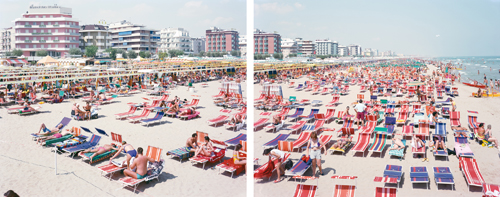Life’s a Beach: The Multi-Portrait
Landscapes of Massimo Vitali
Daniel Levis Keltner
For the last fifteen years, Italian photographer Massimo Vitali has alarmed and captivated audiences with his images of recreational beaches. Their complex juxtapositions of portraiture and landscape illustrate the complexities of both human identity and the social construction that we call nature.
Vitali’s Beach Series is typically exhibited in galleries as mural-sized prints in high detail, a format that serves to intrigue as well as overwhelm the viewer with its high volume of minutiae. However, the sublime is not invoked by size and detail alone. Vitali fascinates viewers by capturing the grotesque in both the mass and the individual in a single image.
Critics often interpret Vitali’s work as heralding the “apotheosis of the Herd.” Of course the force of humans en masse in his Beach Series is undeniable. In photos such as “Riccione Diptych,” a look beyond the glossy travel-ad demeanor reveals a nauseating vision of humanity. Repetition and color work together to convey the conformity and commodification of leisure—perhaps of life—while the vanishing point suggests the pandemic nature of this phenomenon.
Albeit frightening from a distance, the Beach Series bathers appear quite banal upon close inspection. Yet, each figure is unique in his or her banality: a husband watches a younger couple while his wife reads aloud; a boy pours sand on the back of a friend; a young woman negotiates the removal of her top; a couple embraces. And sometimes—in the case of the young girl running to catch up to her father in panel five of “Knokke Poliptych”—they even appear beautiful.
[slider_pro id=”20″]
In fact, Vitali strives to capture the uniqueness of his subjects, photographing “at times when they are not doing the same thing, in situations where they are free to maintain their own personality and individuality.” This individuality is ultimately what causes the eye to linger. And soon, much like the artist, we voyeuristically watch the bathers, inferring stories about persons; as much as they seem to be, we are caught up in the details of their lives.
Vitali’s Beach Series allows viewers to consider the human organism at play from two vantages, capturing both the story of a mass and the story of individuals. Therefore, each photograph can be labeled alternatively as a multi-portrait.
However, in photographs such as “Knokke Poliptych,” the line between portraiture and landscape is not clear. Beneath the placid surface of leisurely activity, buildings, bodies, and beach accoutrement coat the earth, if not threaten to spill off its very edge. This ambiguity of subject—Are we viewing persons or a place?—lends Vitali’s work a deeper significance. In these photos, we see people, place, and more—we witness the tide of humanity in the act of creating the space it occupies. Vitali’s work is essentially a record of that creation: “the beach.”
As landscape, Vitali has not chosen to capture an idyllic Google image of the word “beach.” Instead, he makes us conscious that the reality of public beaches means crowds, beach towels, and hotel chains as much as sand, sun, and sea. Masses of individuals are not the visual pollution of contemporary beaches; they are an inseparable element of the beach environment, whether we are thrilled about that fact or not. Even for those with the money to afford a more exotic experience, the contrived authenticity that goes into many private locales makes the deeming of such beaches “natural” akin to deeming a public park “the woods.” Vitali’s work refuses to capture the idea of the beach and instead presents its current state, packed with all the reality of today’s social concerns: overpopulation, the glorification of the banal, and the contradictory desires for independence and a cultural identity.
[slider_pro id=”21″]
Massimo Vitali once stated that he hopes his photographs serve as both art and social commentary and that they “will be used by sociologists fifty years from now to understand what is happening today.” In the light of our time’s rising concern for environmental issues, I hope people of the future will be more ready to interpret the complexities of Vitali’s multi-portraiture in hand with his complicated use of landscape, challenging the misconception that somewhere there exists a world where there are no people to construct it.
At the very least, Vitali has succeeded in making us stop to reflect on our place in the world, whether that place be beachside or elsewhere, and to consider what we want of the future, what we are making of the present, and how we will construct the past.
Daniel Levis Keltner, Visual Arts Editor
All images Copyright © Massimo Vitali.


Great work. Time we had alternative images of “the beach” which has become such a romanticized notion, in our craving for pristine nature or at least images of pristine nature, when the reality can be quite grim.